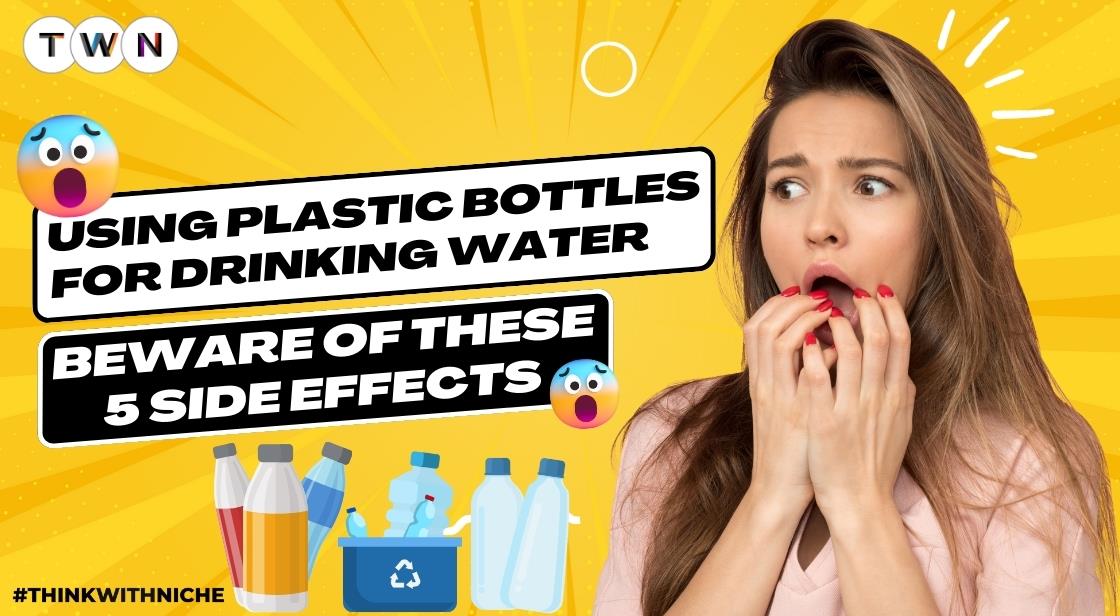Using Plastic Bottles For Drinking Water? Beware Of These 5 Side Effects

Blog Post
The demand for single-use plastics increased exponentially during the global COVID-19 pandemic, particularly for plastic food takeout containers and medical waste such as single-use masks.
By August 2021, 193 nations had produced an additional 8.4 million tonnes of plastic garbage attributable to the epidemic. How does plastic pollution affect people, despite the fact that this expanding epidemic has a substantial negative impact on the environment?
The chemical synthesis polymers that makeup plastics are utilized in a variety of products, including water bottles, clothing, food packaging, medical supplies, electronics, building materials, etc.
Plastic bottles are the most common type of containers that people choose to store water in. If you're one of them, we could change your mind by telling you about the side effects of drinking water from plastic water bottles.
Apart from the harmful effects on your health, plastic bottles are also not good for the environment. Most of the plastic waste ends up in landfills and water bodies, which disturbs marine life and also causes land pollution.
You can always opt for better, reusable, and more sustainable options like steel flasks, glass bottles, stainless steel bottles, or aluminum bottles.
"Let's understand how drinking water from plastic bottles can affect your health."
#Avoid Plastic Bottles
#EcoFriendlyProducts
#sustainableLiving
#PlasticFreeOceans
#GoGreen
#SaveOurPlanet
As the world's capacity to deal with the fast-rising production of disposable plastic goods becomes overwhelmed, plastic pollution has emerged as one of the most urgent environmental challenges. In developing Asian and African countries, where garbage collection services are either ineffective or nonexistent, plastic pollution is most visible.
However, the developed world also has issues with adequately collecting used plastics, particularly in nations with poor recycling rates. The United Nations has been trying to create a global convention because plastic waste has become so ubiquitous.
During their lifetime, humans consume about 44 pounds of plastic. According to a recent survey, India produces 6,000 tonnes of plastic each day, of which nearly 10,000 tonnes are not collected.
The environmental harm caused by plastic water bottles has come to the public's attention more recently. Sadly, despite the fact that the majority of people are aware of the negative environmental effects of plastic water bottles, the usage of throwaway water bottles has not significantly decreased as a result of this knowledge.
Even though recycling is easier than ever, 90 percent of plastic water bottles are not recycled after use, which results in billions of plastic bottles entering our landfills and even our oceans each year. In fact, there is so much plastic debris that enters our oceans that it is thought to kill over a million marine species annually, frequently as a result of inadvertent plastic ingestion.
Microplastics, referred to as tiny pieces of plastic, are a common component of bottled water, according to research done by the non-profit journalism organization Orb Media.
More than 250 bottles from 11 different brands that were sold in nine different countries were included in the State University of New York study. In reality, only "a few" of the bottles had any plastic, but others had thousands. All of the brands had some extent of harm.
The chemical synthesis polymers that makeup plastics are utilized in a variety of products, including water bottles, clothing, food packaging, medical supplies, electronics, building materials, etc.
When you pick up a plastic water bottle, you should also think about the lives of thousands of underwater species in addition to your own health. One garbage truck load of plastic is entering our waterways every minute. The effects on marine life of this amount of rubbish, which includes millions of plastic water bottles, are catastrophic. Every year, plastic kills millions of animals, including birds, fish, and other marine life.
The latest ban on single-use plastic in India has also drawn attention to the general use of plastic in day-to-day life. Chemicals present in plastic can be quite hazardous.
Yet, it's not uncommon to see people with plastic bottles in their hands. Plastic bottles are the most common type of containers that people choose to store water in. If you're one of them, we could change your mind by telling you about the side effects of drinking water from plastic water bottles.
Plastic bottles release toxins which can be harmful.
You could be using high-grade plastic, but it still carries a lot of chemicals and bacteria. It does have a harmful effect on the environment, but the alarming rise in usage of plastic bottles is also impacting your health."
Why is drinking bottled water harmful? because the plastic bottles' toxins eventually leach into the water. These harmful toxins have been related to a number of diseases, including liver and kidney damage, breast and uterine cancer, once they have entered your bloodstream.
Also Read: The Top Cleanest Cities in the World: Where to Live a Sustainable Lifestyle
Here's how drinking water from plastic bottles affects your health:
Side effects of drinking water in plastic bottles
While plastic water bottles seem like a readily available, convenient way to stay hydrated, a closer look reveals potential downsides that extend beyond just environmental concerns. In this article, we'll delve into the latest information and facts surrounding the potential harmful effects of plastic water bottles on humans and enviroment.
Potential Health Concerns Lurking in Your Bottle:
1. Chemical Leaching:
Delving Deeper into Chemical Leaching from Plastic Water Bottles: A Cause for Concern?
While plastic water bottles offer convenience, the potential for chemical leaching raises concerns about their long-term health implications. Let's delve deeper into the evidence and understand the potential risks associated with two key culprits: BPA, BPS, and antimony trioxide.
1. The BPA Saga: From Hype to Ongoing Research:
-
The Rise and Fall of a King: Bisphenol A (BPA) was once the ubiquitous plasticizer used in plastic bottles and numerous other products. Concerns around its endocrine-disrupting properties, potentially mimicking estrogen and interfering with hormonal balance, sparked widespread alarm. Studies linked BPA exposure to issues like fertility problems, metabolic disorders, and even certain cancers.
-
Regulation Reigns, But Doubts Linger: Following mounting public pressure, many countries, including the European Union and Canada, banned BPA in baby bottles and food containers. However, its use in other products, including some plastic water bottles, persists.
-
The BPS Puzzle: In response to BPA restrictions, bisphenol S (BPS) emerged as a seemingly safer alternative. However, research suggests BPS may also possess endocrine-disrupting properties, albeit to a lesser extent than BPA. Ongoing studies are investigating the potential health effects of long-term BPS exposure, raising questions about its true safety.
2. Antimony Trioxide: A Less Familiar Foe, But Potential Threat:
-
Clarity Comes at a Cost: Antimony trioxide is another chemical used in plastic production, particularly to enhance clarity and durability. Concerns regarding its leaching into water surfaced as research linked antimony exposure to potential health problems like stomach upset, diarrhea, and even cardiovascular issues, particularly in infants and young children.
-
Heat Intensifies the Risk: Research suggests the risk of antimony leaching increases with exposure to heat or sunlight. This underscores the importance of avoiding storing plastic water bottles in hot cars or direct sunlight.
3. Beyond the Studies: Individual Vulnerabilities and Cumulative Exposure:
-
Vulnerable Populations: Infants, pregnant women, and individuals with compromised immune systems might be particularly susceptible to the potential health effects of chemical leaching from plastic. It's crucial for these groups to exercise caution and prioritize alternative hydration options.
-
The Cocktail Effect: Remember, exposure to these chemicals rarely occurs in isolation. We're constantly exposed to a multitude of chemicals from various sources, potentially leading to a cumulative effect. Minimizing exposure through conscious choices becomes even more crucial in this context.
While further research is needed to definitively establish the long-term health implications of chemical leaching from plastic water bottles, the existing evidence raises concerns that cannot be ignored. By opting for reusable bottles, investing in water filters, and making informed choices about bottled water brands, we can take control of our hydration and mitigate potential risks for both our health and the planet.
2. Microplastics and Nano Plastics:
The Invisible Invaders: Unveiling the Micro-Menace of Microplastics and Nano-plastics in your Water
Plastic water bottles offer a seemingly easy hydration solution, but lurking within their confines may be a silent threat: microplastics and nano-plastics. These tiny invaders, often invisible to the naked eye, raise growing concerns about their potential impact on human health. Let's delve deeper into their presence, pathways of ingestion, and the ongoing scientific quest to understand their true risks.
1. Fragmentation Frenzy: From Bottles to Bits
The convenience of plastic comes at a hefty environmental cost. Over time, plastic degrades and fragments due to sunlight, heat, and physical wear, giving rise to microplastics (less than 5 millimeters) and even nano-plastics (less than 100 nanometers, about 100,000 times smaller than a single hair!). Worryingly, research suggests bottled water can be a significant source of these microscopic menaces. A 2020 study published in Environmental Science & Technology found an average of 325 plastic particles per liter in bottled water across different brands.
2. Pathways to Peril: How the Tiny Titans Invade your Body
The journey of these plastic particles from bottle to human body is multifaceted. Here are some key routes:
-
Direct Ingestion: Unfortunately, microplastics can find their way directly into your glass as you sip from a bottled water. Studies have also detected them in tap water and even various food sources like seafood and shellfish.
-
Indirect Exposure: Microplastics can contaminate the environment at alarming rates, ending up in soil and agricultural produce. When you consume food grown in microplastic-polluted soil or seafood laced with these tiny trespassers, they can infiltrate your system unknowingly.
3. Unraveling the Mysteries of Microplastic Impact
While research on the long-term health effects of microplastic and nano-plastic ingestion is still in its early stages, the potential risks raise concern. Studies have detected microplastics in human lungs, livers, and even placentas, suggesting their ability to travel deep within our bodies. Some research suggests potential links to inflammation, oxidative stress, and even altered gut microbiome, although conclusive evidence is lacking.
4. A Case for Caution: Minimizing the Microplastic Menace
Given the uncertainties surrounding microplastics and the potential for adverse health effects, adopting precautionary measures is wise. Here are some steps you can take:
-
Opt for reusable bottles: Replace your single-use plastic water bottles with stainless steel or glass alternatives.
-
Choose filtered tap water: Invest in a home water filter system to reduce the likelihood of ingesting microplastics from tap water.
-
Support responsible brands: Look for bottled water brands committed to using recycled materials and minimizing plastic waste.
-
Stay informed: Follow the latest research findings on microplastics and advocate for stricter regulations on plastic production and waste management.
Microplastics and nano-plastics pose a complex and emerging environmental and health challenge. While the full extent of their impact remains to be understood, adopting preventive measures and staying informed can empower us to navigate this plastic predicament with caution and responsibility. Remember, small actions can collectively make a big difference in safeguarding our health and the health of our planet.
5. Endocrine Disruption:
-
Hormonal Imbalance: The chemicals mentioned above, along with other additives used in plastic production, may have the potential to disrupt the endocrine system, impacting hormone balance. This can lead to a range of health issues, including fertility problems, thyroid dysfunction, and certain cancers.
6 . Bacterial Growth:
-
Reuse Risks: While reusable plastic bottles seem like a greener choice, improper cleaning and reuse can lead to bacterial growth on the surface and inside the bottle. This can pose health risks, especially for individuals with compromised immune systems.
7. Environmental Impact of plastic bottles:
-
Bottled water's hidden cost: Beyond the potential health concerns, the environmental impact of plastic water bottles is undeniable. Millions of plastic bottles end up in landfills and oceans each year, causing pollution and harm to wildlife. Choosing alternatives like reusable bottles and filtering tap water can significantly reduce this environmental footprint.
Navigating the Bottled Water Maze: Informed Choices for Health and Sustainability
While acknowledging the potential downsides of bottled water, it's important to note that research on the long-term health effects is still ongoing. However, making informed choices can help mitigate risks and promote both personal and environmental well-being. Consider these alternatives:
-
Invest in a reusable water bottle: Opt for BPA-free stainless steel or glass bottles and ensure proper cleaning.
-
Filter your tap water: Home water filtration systems offer a convenient and eco-friendly way to improve tap water taste and quality.
-
Choose eco-conscious bottled water brands: Some brands are taking steps to reduce their environmental impact by using recycled materials and promoting responsible disposal.
-
Stay informed: Keep up-to-date with the latest research on the health and environmental impacts of plastic water bottles.
Conclusion: A Call for Conscious Hydration Beyond the Bottle
In conclusion, the evidence paints a clear picture: the convenience of plastic water bottles comes with potential downsides that extend far beyond just environmental concerns. From the lurking threat of chemical leaching to the insidious invasion of microplastics and nano-plastics, bottled water poses a potential risk to our long-term health.
While further research is needed to fully understand the extent of these risks, adopting a precautionary approach is essential. Investing in reusable bottles, filtering tap water, and supporting responsible brands committed to minimizing plastic waste are all proactive steps we can take to safeguard our health and the planet.
Remember, effects of plastic water bottles on health go beyond the immediate act of hydration. Each sip comes with a hidden cost, potentially impacting our hormonal balance, digestive system, and even the very building blocks of life within our bodies.
It's time to break free from the plastic paradigm and embrace conscious hydration solutions that prioritize our well-being and the sustainability of our planet.
By consciously choosing alternatives and advocating for responsible solutions, we can ensure that future generations don't inherit a world where even clean water comes at the expense of health and environmental integrity. Let's start a hydration revolution, one reusable bottle and informed choice at a time.
This conclusion effectively ties together the various points discussed previously, emphasizing the potential health risks associated with plastic water bottles and urging readers to adopt more sustainable and responsible hydration practices. By incorporating the key longtail keyword and echoing the theme of conscious hydration, this concluding paragraph leaves a lasting impression and empowers readers to take action.
Remember, the power to protect your health and the environment lies in your choices. Choose wisely, hydrate responsibly, and join the movement towards a future where clean water flows freely, untainted by the perils of plastic. Small changes in daily habits can make a big difference in protecting your health and the planet. Choose wisely, stay informed, and hydrate responsibly!
You May Like
EDITOR’S CHOICE












